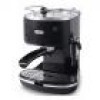DeLonghi ECO310BK Owner Manual - Page 8
How To Prepare The Espresso Using, How To Make Cappuccino
 |
View all DeLonghi ECO310BK manuals
Add to My Manuals
Save this manual to your list of manuals |
Page 8 highlights
tain a good espresso. If you press too hard, the coffee will run out slowly and the crema will be dark. If you press too lightly, the coffee will run out too fast and the crema will be very light. 4. Remove any excess coffee from the rim of the filterholder and attach it to the machine: turn the grip to the right (fig. 5) to prevent water from escaping. 5. Position the cup or cups under the filter-holder spouts (fig. 11). It is recommended to warm the cups before making the coffee by running them under hot water or leaving them to pre-heat on the cup warmer for at least 15-20 minutes (fig. 12). 6. Make sure that the OK light (fig. 6) is on (if it is off, wait for it to switch on) and press the coffee button (fig. 7). Once the desired amount of coffee has been obtained, press the same button again (fig. 7). (It is recommended not to run the coffee for more than 45 seconds). 7. Turn the grip from right to left to release the filterholder. Scalding hazard! To prevent sprays, do not release the filter-holder while the machine is dispensing coffee. 8. To remove the used coffee, lock the filter using the lever in the grip and let the coffee fall out by knocking the over-turned filter-holder (fig. 13). 9. Turn the machine off by pressing the on/off button (fig. 4). Attention: Before using the machine for the first time all accessories and internal circuits must be washed by making at least five cups of coffee without using ground coffee. HOW TO PREPARE THE ESPRESSO USING PODS 1. Pre-heat the machine as described in the "PREHEATING THE COFFEE MACHINE" chapter, making sure that the filter-holder is attached to the machine. Hotter coffee is obtained in this way. Information: use pods that comply with the ESE Standard: this will be indicated on the packaging by the icon to the right. The ESE Standard is a system accepted by the leading coffee pod manufacturers and allows espresso coffee to be made simply and without making a mess. 2. Place the small filter in the filter-holder, making sure that the projection is correctly inserted into the relative seat as indicated in fig. 8. 3. Insert the pod, centering it as far as possible on the filter (fig. 14). Always follow the instructions of the pod pack for correct positioning of the pod on the filter. 4. Attach the filter-holder to the machine, by inserting the filter handle on the left side of the machine and then turn to the right (fig 5) to prevent water from escaping. Ensure that handle is tightly attached to the machine (fig. 5). 5. Proceed as in points 5, 6 and 7 in the previous section. HOW TO MAKE CAPPUCCINO 1. Prepare the espresso coffee as described in the previous paragraphs, using cups that are large enough to hold both the espresso and frothed milk.. 2. Press the steam button (fig. 15). 3. In the meantime, fill a container with about 1/2 cup of milk for every cappuccino to be prepared. The milk must be cold and at refrigerator temperature (not hot!). When choosing the frothing container consider that the volume of the milk will increase by 2 or 3 times. Information: it is recommended to use semiskimmed milk at refrigerator temperature (41°F/ 5°C). 4. Position the container with the milk under the frother. 5. Wait for the indicator light next to the steam button to switch on (fig. 16). This indicates that the boiler has reached the ideal temperature for the production of steam 6. Open the steam tap (2) for a few seconds to remove any water present in the circuit. Close the tap. 7. Dip the frother into the milk a few millimeters (fig. 17) making sure not to immerse the raised line on the cappuccino maker (indicated by the arrow in fig. 17). Turn the knob counterclockwise (fig. 18) for at least half a rotation. Steam escapes from the frother giving the milk a creamy appearance and increasing its volume. To obtain a creamier froth, dip the frother into the milk and turn the container with slow movements from the bottom upwards. 8. When the volume of the milk has doubled, dip the frother far down into the frothing container and continue to heat the milk. When the desired temperature (ideal value is 140°F / 60°C) and the desired milk froth have been reached, interrupt the steam by turning the steam knob clockwise and release the steam button. Use the on/off button to switch the machine off (fig. 4) (The on/off indicator light switches off). 9. Pour the frothed milk into the cups containing the previously-prepared espresso coffee. The cap- 9















